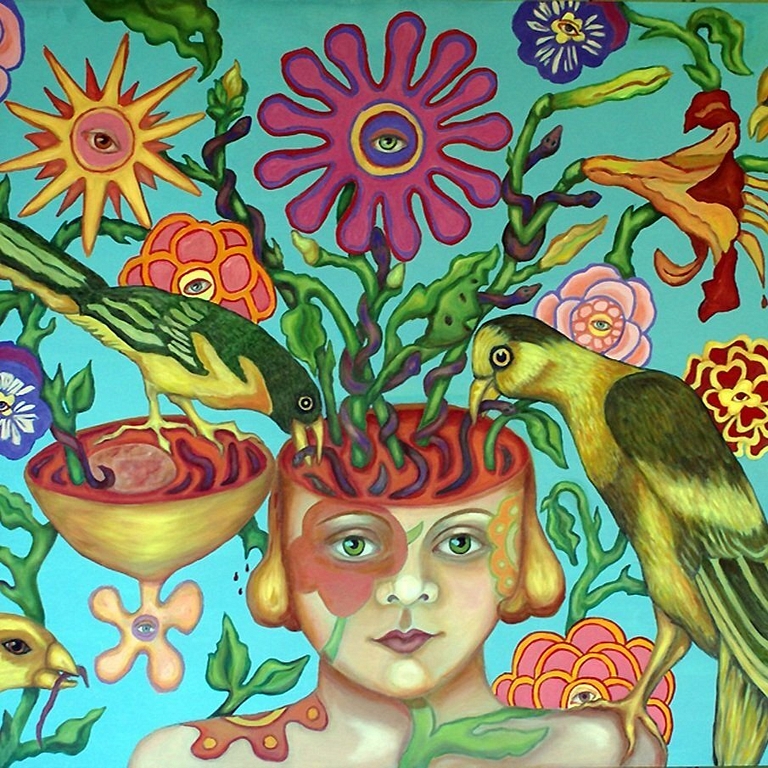
Joan Wheeler
Creation.
Joan Wheeler’s Creation — in addition to being a real display of artistic invention — can be approached as a metaphor for both making art and remembering things, as creativity and memory can sometimes feel perhaps too large for our brains, and both can seem thrilling and frightening. How often does an artistic project head off in directions the creator didn’t forsee? How often do memories, pleasant or unpleasant, flit through our consciousness whether we want them to or not? Both can overwhelm to the point of being almost predatory. But where, even who, would we be without them?
Creation ties together several themes at play in “Storytellers,” a show put up by the Ely Center of Contemporary Art running simultaneously at its Trumbull Street space until July 17 and at Perspectives, the gallery at the Whitney Center in Hamden until Sept. 9. “Sharing stories is one of the most primal forms of communication, enabling us to document real events, dream states, unconscious realms, sacred spheres, and unknown dimensions,” an accompanying note reads. “The nine artists in this show tell visual stories that include characters — fictionalized, historic, dream-like — achieved through abstract narratives, material exploration and figuration to convey ideas about their personal experiences, places, and the human condition.”

Kwadwo Adae
Kerry.
The works of the artists in the show (Kwadwo Adae, Matthew Best, Jenn Cacciola, James Cofrancesco, Tyler Cofrancesco, Mary Dwyer, Anya Kotler, Melissa Sutherland Moss, and Joan Wheeler) run with the above themes in several different directions. The subject of Kwadwo Adae’s Kerry — activist and community organizer Kerry Ellington — is immediately recognizable to those who followed the news in New Haven in 2020, particularly regarding Black Lives Matter protests. Adae humanizes her, showing her in action, bullhorn in hand, doing the work that led to her being recognized as a community leader, rather than having her sit for a formal portrait after the fact. She was in the midst of creating her story when Adae painted her, and she’s writing that story still.

Mary Dwyer
Wendy Winters' Last Day in the Office.
Mary Dwyer’s small, whimsical portraits, meanwhile, show people at turning points in their lives. She has them all hung under the caption “Last Day of Work,” and they involving not just a final stroll around the office, but lingering at a car wash, standing outside the family business, getting into a car. There’s a sense of friendly everydayness about all of Dwyer’s images — as if to say that all the subjects of her paintings will do okay by their choices — and also a bit of the iconographic, as if seeking to freeze the curve of their personal narratives in time.

Matthew Best.
If they were photographs, the array of paintings in Matthew Best’s contribution to the show might seem almost like they were taken with a phone by accident. They’re pictures in which the subjects’ faces are often cropped, and we’re left to examine their torsos, their flannel shirts, their hairy chests. They are, in other words, the fleeting random images that are a lot more like the things we usually look at in the course of our day, rather than the composed images that are usually the subject of art, or even, for that matter, a selfie. By taking the time to paint these images, Best asks the viewer to linger in the moments he captures. Maybe each of them in isolation doesn’t have a lot of meaning in it, and yet, taken as a whole, they are the kinds of images that make up most of a life.

Anya Kotler
Seems Like a Good Thing.
Meanwhile, Anya Kotler, like a few other artists in the exhibit, gets a little surreal in capturing moments that seem to convey narratives, a host of meanings. One gets the sense that in a conversation with Kotler, one might be able to decode the painting, explain it all away with personal anecdotes and reflections. But Kotler’s pieces aren’t about simply divulging answers or biographical information; they’re about conveying a certain mixture of feelings and perhaps evoking them in the viewer; they’re about presenting a worldview.
Kotler’s pieces also get at the way the stories we tell about our lives are in some ways an imposition of order, meaning grafted onto memories after the fact. Meanwhile, the real stuff of life is in some ways as opaque as the worried expressions of strangers on the street, the conversations on phones we’re too far away to hear, or a flickering face in a coffee cup, distorted by the ripples in the liquid and soon gone when the cup is empty.
“Storytellers” runs at the Ely Center of Contemporary Art, 51 Trumbull St., through July 17, and Perspectives, the gallery at Whitney Center, 200 Leeder Hill Dr., Hamden, through Sept. 9. Visit ECOCA’s website for hours and more information.